山东大学:《生物医学信号处理 Biomedical Signal Processing》精品课程教学资源(PPT课件讲稿)Chapter 05 Transform Analysis of Linear Time-Invariant Systems
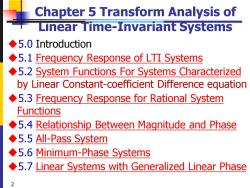
Chapter 5 Transform Analysis of Linear Time-Invariant Systems ◆5.0 Introduction 5.1 Frequency Response of LTI Systems 5.2 System Functions For Systems Characterized by Linear Constant-coefficient Difference equation 5.3 Frequency Response for Rational System Functions 5.4 Relationship Between Magnitude and Phase ◆5.5All-Pass System 5.6 Minimum-Phase Systems 5.7 Linear Systems with Generalized Linear Phase 2
Chapter 5 Transform Analysis of Linear Time-Invariant Systems ◆5.0 Introduction ◆5.1 Frequency Response of LTI Systems ◆5.2 System Functions For Systems Characterized by Linear Constant-coefficient Difference equation ◆5.3 Frequency Response for Rational System Functions ◆5.4 Relationship Between Magnitude and Phase ◆5.5 All-Pass System ◆5.6 Minimum-Phase Systems ◆5.7 Linear Systems with Generalized Linear Phase 2
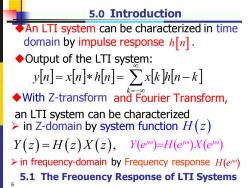
5.0 Introduction An LTI system can be characterized in time domain by impulse response[]. Output of the LTI system: yIn]=xIn]*hin]=>xkhin-k] With Z-transform and Fourier Transform, an LTI system can be characterized >in Z-domain by system function H(z) Y(z)=H(z)X(z),Y(e)=H()x(e) in frequency-domain by Frequency response H(e) 5.1 The Freouency Response of LTI Systems 6
5.0 Introduction ◆An LTI system can be characterized in time domain by impulse response . ◆Output of the LTI system: h n =− = = − k y n x n h n x k h n k Y z H z X z ( ) = ( ) ( ), ➢ in Z-domain by system function ➢ in frequency-domain by Frequency response ( ) ( ) ( ) j j j Y e H e X e = ◆With Z-transform an LTI system can be characterized H z( ) ( ) H ej and Fourier Transform, 6 5.1 The Freouency Response of LTI Systems
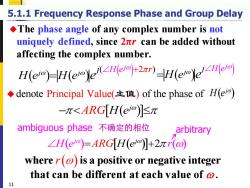
5.1.1 Frequency Response Phase and Group Delay The phase angle of any complex number is not uniquely defined,since 2nr can be added without affecting the complex number. H@)HH(eYeKMoy2nrHF1(@wY-Hm) ◆denote Principal Value(主值)of the phase of H(eo) -π<ARG[H(eo]≤π ambiguous phase不确定的相位 arbitrary ∠H(eo)=ARG[H(e]+2rr(o where r(@)is a positive or negative integer that can be different at each value of o. 11
5.1.1 Frequency Response Phase and Group Delay ◆The phase angle of any complex number is not uniquely defined, since 2πr can be added without affecting the complex number. ( ) ( ) 2 ( ) H ej H j ARG e r = + ( ) H ej ARG − ◆denote Principal Value(主值) of the phase of ( ) H ej ambiguous phase 11 where is a positive or negative integer r() 不确定的相位 ( ) ( ) ( ( ) 2 ) j j j j H e r H e H e e + = ( ) j ( ) j j H e H e e = arbitrary that can be different at each value of
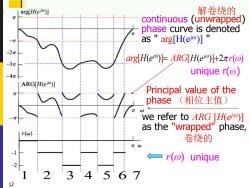
arg[H(e)] 解卷绕的 入 continuous (unwrapped) phase curve is denoted 一7T as "arg[H(el)] -2π arg H(e)=ARGH(e)+2r(@ -3T -4π unique r() ARG[H(e)] n Principal value of the phase(相位主值) we refer to ARG [H(ei)] as the e "wrapped"phase r(@) 卷绕的 TW ←一r(o) unique 3'4 12
1 2 3 4 5 6 7[ ( ) ] j arg H e = we refer to ARG [ H( ej )] as the "wrapped" phase , continuous (unwrapped) phase curve is denoted as " arg[H(ej )] " 卷绕的 解卷绕的 [ ( ) ] 2 ( ) H ej ARG r + Principal value of the phase (相位主值) 12 r () unique r( ) unique
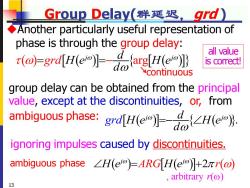
Group delay( 群延迟,gd) Another particularly useful representation of phase is through the group delay: all value ()-grdu is correct! continuous group delay can be obtained from the principal value,except at the discontinuities,or,from ambiguous phase:grd[H(e】=a{∠Hleo} ignoring impulses caused by discontinuities. ambiguous phase∠H(em)=ARGH(em】+2rr(o) ,arbitrary(o) 13
Group Delay(群延迟,grd ) ( ) ( ) arg ( ) j j d grd H e H e d = =− group delay can be obtained from the principal value, except at the discontinuities, ◆Another particularly useful representation of phase is through the group delay: ( ) ( ) 2 ( ) H e H j j ARG r e = + continuous ambiguous phase , arbitrary r() 13 ( ) ( ). j j d g d H e H e d r =− ignoring impulses caused by discontinuities. or, from ambiguous phase: all value is correct!
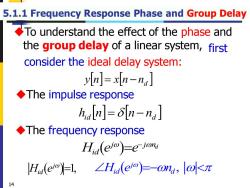
5.1.1 Frequency Response Phase and Group Delay To understand the effect of the phase and the group delay of a linear system,first consider the ideal delay system: yn =xn-na. ◆The impulse response haln]=n-na The frequency response Hid(ej)-e jon H(el,∠Hna(eo)=-u,ll水k元 14
5.1.1 Frequency Response Phase and Group Delay hid n = n − nd n nd y n = x − ( ) d j j n H e e id − = ( ) 1, j H e id = ( ) , j H e n id d =− ◆The frequency response ◆The impulse response ◆To understand the effect of the phase and the group delay of a linear system, first consider the ideal delay system: 14
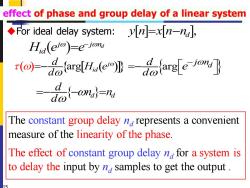
effect of phase and group delay of a linear system For ideal delay system:n Hid(eio)e-jon r(a)-farg(arge or =%{-om}, The constant group delay nrepresents a convenient measure of the linearity of the phase. The effect of constant group delay na for a system is to delay the input by n samples to get the output
effect of phase and group delay of a linear system ◆For ideal delay system: d d d n n d =− − = The constant group delay nd represents a convenient measure of the linearity of the phase. The effect of constant group delay nd for a system is to delay the input by nd samples to get the output . ( ) arg ( ) j id d H e d =−( ) d j j n H e e id − = , y n x n n = − d 15 arg d d j n d e − =− The constant group delay represents a convenient
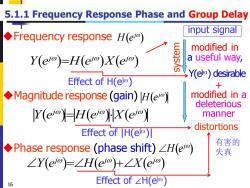
5.1.1 Frequency Response Phase and Group Delay input signal Frequency response H(el) modified in Y(eo)=lH(eo)X(em) a useful way, Ye)desirable Effect of H(ei) 十 Magnitude response (gain)H(ei) modified in a deleterious Y(ei-H(ei)X(e) manner distortions Effect of |H(eo刃 ◆Phase response(phase shift)∠H(eo) 有害的 失真 ∠Y(eo)=∠H(eo+∠X(eo) 16 Effect of∠H(eio)
5.1.1 Frequency Response Phase and Group Delay ( ) ( ) ( ) j j j Y e H e X e = ( ) ( ) ( ) j j j Y e H e X e = ◆Phase response (phase shift) ( ) H ej ( ) ( ) ( ) j j j Y e H e X e = + ( ) ◆ H ej Frequency response ( ) ◆Magnitude response H ej (gain) distortions modified in a useful way, system input signal 16 Y(e j) desirable + modified in a deleterious manner Effect of H(ej) Effect of |H(ej)| Effect of ∠H(ej) 有害的 失真
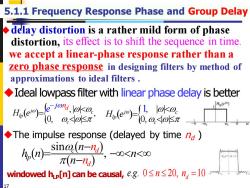
5.1.1 Frequency Response Phase and Group Delay delay distortion is a rather mild form of phase distortion,its effect is to shift the sequence in time. we accept a linear-phase response rather than a zero phase response in designing filters by method of approximations to ideal filters Ideal lowpass filter with linear phase delay is better ue-本2e四设apgn Hp(e) The impulse response(delayed by time nd) (sing( 元(n-nu -00<1n<00 Ht四相=9 windowed hpl[n]can be causal,,e.g.0≤n≤20,n=l0 17
5.1.1 Frequency Response Phase and Group Delay ◆Ideal lowpass filter with linear phase delay is better ( ) ,| | , 0, | | j c lp c d j n H e e − = ◆delay distortion is a rather mild form of phase distortion, ◆The impulse response (delayed by time nd ) its effect is to shift the sequence in time. 17 in designing filters by method of approximations to ideal filters . windowed hLP[n] can be causal, ( ) ( ) ( ) sin , c d lp d n h n n n n n − = − − we accept a linear-phase response rather than a zero phase response . . 0 20, 10 d e g = n n ( ) , | | 0, | | j 1 c lp c H e =
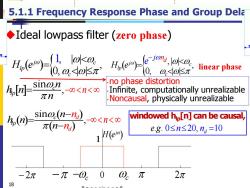
5.1.1 Frequency Response Phase and Group Dela Ideal lowpass filter (zero phase) e-ae生 e8 0,o4o昨元 linear phase a,-s1ng”,o<n< no phase distortion Infinite,computationally unrealizable 元n Noncausal,physically unrealizable sin@(n-na)oo<n<c windowed hp[n]can be causal, π(n-na) 1H(e) e.g.0≤n≤20,n=l0 -2π 0 π 2元 18
5.1.1 Frequency Response Phase and Group Delay ◆Ideal lowpass filter (zero phase) ( ) j H e − 2 − −c 0 c 2 1 sin , c lp n h n n = 18 − n k y n x k h n k =− = − windowed hlp[n] can be causal, . . 0 20, 10 d e g = n n •no phase distortion •Infinite, computationally unrealizable •Noncausal, physically unrealizable ( ) ,| | , 0, | | j c lp c d j n H e e − = ( ) ( ) ( ) sin , d d c lp n h n n n n − = − ( ) , | | , 0, | | j 1 c lp c H e = − n linear phase
按次数下载不扣除下载券;
注册用户24小时内重复下载只扣除一次;
顺序:VIP每日次数-->可用次数-->下载券;
- 山东大学:《生物医学信号处理 Biomedical Signal Processing》精品课程教学资源(PPT课件讲稿)Chapter 04 Sampling of Continuous-Time Signals.ppt
- 山东大学:《生物医学信号处理 Biomedical Signal Processing》精品课程教学资源(PPT课件讲稿)Chapter 03 the Z-transform.ppt
- 山东大学:《生物医学信号处理 Biomedical Signal Processing》精品课程教学资源(PPT课件讲稿)Chapter 08 The Discrete Fourier Transform.ppt
- 山东大学:《生物医学信号处理 Biomedical Signal Processing》精品课程教学资源(PPT课件讲稿)Chapter 01 Introduction(主讲:刘忠国).ppt
- 上海交通大学:《遗传学实验 Genetics Experiments》教学资源(课程PPT)绪论.ppt
- 上海交通大学:《遗传学实验 Genetics Experiments》教学资源(实验PPT)果蝇唾腺染色体的观察.ppt
- 上海交通大学:《遗传学实验 Genetics Experiments》教学资源(实验PPT)果蝇实验技术与果蝇杂交实验.ppt
- 上海交通大学:《遗传学实验 Genetics Experiments》教学资源(实验讲稿)果蝇的生活史、遗传性状观察及其饲养.pdf
- 上海交通大学:《遗传学实验 Genetics Experiments》教学资源(课程PPT)果蝇饲养准备.pdf
- 上海交通大学:《生命科技与人类生活》教学资源(课程讲稿)干细胞技术 Stem Cells.pdf
- 上海交通大学:《生命科技与人类生活》教学资源(课程讲稿)转基因技术 Transgenic technology.pptx
- 上海交通大学:《生命科技与人类生活》教学资源(课程讲稿)转基因技术 Transgenic technology.pdf
- 上海交通大学:《生命科技与人类生活》教学资源(课程讲稿)生命科学和诺贝尔奖 Life science and Nobelpriset.pptx
- 上海交通大学:通识教育核心课程《生命科学发展史 A History of Life Science》教学资源(课件讲稿)第四讲 人体生理学——人类的自我认识.pdf
- 上海交通大学:通识教育核心课程《生命科学发展史 A History of Life Science》教学资源(课件讲稿)第六讲 从细胞学说到胚胎发育.pdf
- 上海交通大学:通识教育核心课程《生命科学发展史 A History of Life Science》教学资源(课件讲稿)第五讲 走近微生物世界.pdf
- 上海交通大学:通识教育核心课程《生命科学发展史 A History of Life Science》教学资源(课件讲稿)第二讲 从古代哲学到近代科学.pdf
- 上海交通大学:通识教育核心课程《生命科学发展史 A History of Life Science》教学资源(课件讲稿)第三讲 生物的分类和演化.pdf
- 上海交通大学:通识教育核心课程《生命科学发展史 A History of Life Science》教学资源(课件讲稿)第一讲 人类起源与发展.pdf
- 上海交通大学:通识教育核心课程《生命科学发展史 A History of Life Science》教学资源(课件讲稿)绪论(孟和).pdf
- 山东大学:《生物医学信号处理 Biomedical Signal Processing》精品课程教学资源(PPT课件讲稿)Chapter 06 structures for discrete-time system.ppt
- 山东大学:《生物医学信号处理 Biomedical Signal Processing》精品课程教学资源(PPT课件讲稿)Chapter 09 Computation of the Discrete Fourier Transform.ppt
- 山东大学:《生物医学信号处理 Biomedical Signal Processing》精品课程教学资源(PPT课件讲稿)Chapter 02 Discrete-Time Signals and Systems.ppt
- 山东大学:《生物医学信号处理 Biomedical Signal Processing》精品课程教学资源(PPT课件讲稿)Chapter 07 Filter Design Techniques.ppt
- 山东大学:《生物医学信号处理 Biomedical Signal Processing》精品课程教学资源(试卷与答案)A卷-2012_试卷.doc
- 山东大学:《生物医学信号处理 Biomedical Signal Processing》精品课程教学资源(试卷与答案)A卷-2012_答案.doc
- 山东大学:《生物医学信号处理 Biomedical Signal Processing》精品课程教学资源(试卷与答案)B卷-2012_试卷.doc
- 山东大学:《生物医学信号处理 Biomedical Signal Processing》精品课程教学资源(试卷与答案)B卷-2012_答案.doc
- 山东大学:《生物医学信号处理 Biomedical Signal Processing》精品课程教学资源(试卷与答案)A卷-2019_试卷.doc
- 山东大学:《生物医学信号处理 Biomedical Signal Processing》精品课程教学资源(试卷与答案)A卷-2019_答案.doc
- 山东大学:《生物医学信号处理 Biomedical Signal Processing》精品课程教学资源(试卷与答案)A卷-2018_试卷.doc
- 山东大学:《生物医学信号处理 Biomedical Signal Processing》精品课程教学资源(试卷与答案)A卷-2018_答案.doc
- 山东大学:《生物医学信号处理 Biomedical Signal Processing》精品课程教学资源(试卷与答案)B卷-2017_试卷.doc
- 山东大学:《生物医学信号处理 Biomedical Signal Processing》精品课程教学资源(试卷与答案)B卷-2017_答案.doc
- 山东大学:《生物医学信号处理 Biomedical Signal Processing》精品课程教学资源(试卷与答案)A卷-2016_试卷.doc
- 山东大学:《生物医学信号处理 Biomedical Signal Processing》精品课程教学资源(试卷与答案)A卷-2016_答案.doc
- 山东大学:《生物医学信号处理 Biomedical Signal Processing》精品课程教学资源(试卷与答案)A卷-2015_试卷.doc
- 山东大学:《生物医学信号处理 Biomedical Signal Processing》精品课程教学资源(试卷与答案)A卷-2015_答案.doc
- 山东大学:《生物医学信号处理 Biomedical Signal Processing》精品课程教学资源(试卷与答案)A卷-2014_试卷.doc
- 山东大学:《生物医学信号处理 Biomedical Signal Processing》精品课程教学资源(试卷与答案)A卷-2014_答案.doc
